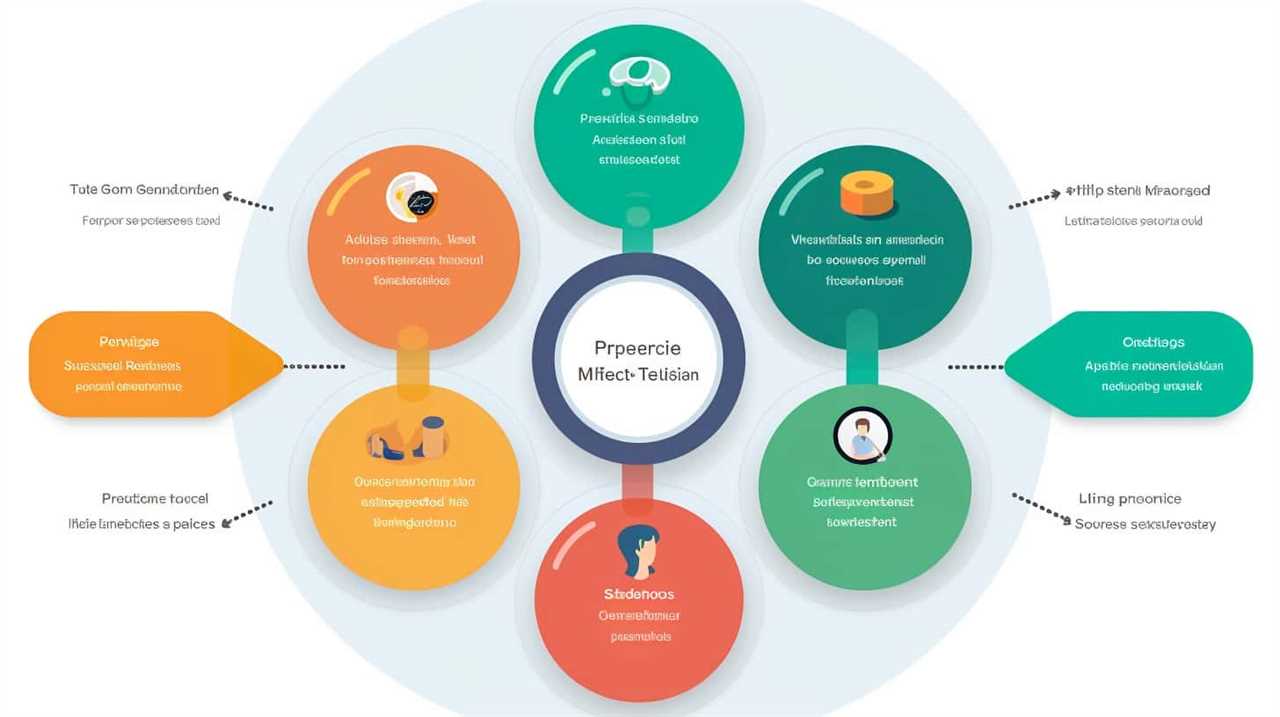If you design custom footwear and are looking to boost your online presence, look no further!
In our article, we’ll guide you through the world of SEO, helping you reach your target audience and boost your website’s visibility.
From keyword research to on-page optimization techniques, we’ve got you covered.
Stay ahead of the game and master the art of SEO to take your custom footwear business to new heights.

Let’s dive in and make your online presence shine!
Key Takeaways
- SEO strategies increase online visibility and attract organic traffic
- Audience segmentation tailors marketing strategies to specific customer groups
- Targeting niche keywords attracts the right audience and improves search engine rankings
- Optimizing title tags, meta descriptions, and content for search engines
Importance of SEO for Custom Footwear Makers
In our experience as custom footwear makers, we’ve found that implementing effective SEO strategies is crucial for increasing online visibility and reaching potential customers. In a competitive market, it’s essential to have a strong online presence that allows your custom footwear business to stand out from the crowd. By utilizing SEO strategies specifically tailored for custom footwear makers, you can improve your website’s ranking on search engine results pages and attract more organic traffic.
To succeed in a competitive market, it’s important to measure the success of your SEO efforts. One way to do this is by monitoring your website’s search engine rankings for relevant keywords related to custom footwear. By tracking your rankings over time, you can assess the effectiveness of your SEO strategies and make necessary adjustments to improve your visibility.
Another way to measure the success of your SEO efforts is by analyzing website analytics data. By examining metrics such as website traffic, bounce rate, and conversion rate, you can gain insights into the effectiveness of your SEO strategies in driving organic traffic and converting visitors into customers.

Understanding your target audience is crucial for developing effective SEO strategies. By analyzing your audience’s demographics, interests, and online behavior, you can create targeted content and optimize your website to attract and engage your ideal customers.
In the next section, we’ll delve deeper into the importance of understanding your target audience and how it can further enhance your SEO efforts.
Understanding Your Target Audience
To further enhance our SEO efforts as custom footwear makers, it’s imperative that we gain a deep understanding of our target audience. Effective audience segmentation is crucial in order to tailor our marketing strategies and messages to specific groups of customers. By dividing our audience into different segments based on demographics, preferences, and buying behaviors, we can create personalized experiences that resonate with each segment.
As custom footwear businesses, personalization strategies should be at the forefront of our marketing efforts. This means going beyond general targeting and delivering content and offers that are highly relevant and tailored to individual customers. By leveraging data and analytics, we can identify patterns and trends within our target audience, allowing us to offer customized products and experiences that meet their specific needs and desires.

One effective personalization strategy is to create targeted landing pages for different segments of our audience. These landing pages can be designed to showcase the specific styles, colors, or materials that each segment is interested in. By delivering a personalized experience from the moment a customer lands on our website, we can increase engagement and conversion rates.
Understanding our target audience is crucial for the success of our SEO efforts as custom footwear makers. By implementing effective audience segmentation and personalization strategies, we can create a highly targeted and engaging online presence that attracts and converts our ideal customers.
Keyword Research and Analysis
When it comes to SEO for custom footwear makers, keyword research and analysis is crucial.
Targeting niche keywords that are specific to your products will help you attract the right audience and increase your chances of ranking higher in search engine results.

Additionally, conducting competitor keyword analysis will give you insights into what keywords your competitors are targeting and how you can differentiate yourself.
Targeting Niche Keywords
Our team actively conducts keyword research and analysis to identify the most relevant and profitable niche keywords for custom footwear makers. This process involves in-depth niche market research to understand the specific needs and preferences of our target audience.
We then employ long tail keyword targeting, which involves using longer and more specific keywords that have lower competition but higher conversion rates.
By focusing on niche keywords, we can attract highly targeted traffic to our client’s website, increasing the chances of conversions and sales.

This approach allows us to optimize our client’s website for the specific needs of their target market, ensuring that they’re visible to potential customers who are actively searching for custom footwear.
Competitor Keyword Analysis
After conducting thorough keyword research and analysis, we discovered valuable insights through competitor keyword analysis. Competitor analysis techniques allowed us to gain a deeper understanding of how our competitors are using keywords to attract customers.
By identifying competitor keyword strategies, we were able to uncover new keyword opportunities and areas where we can improve our own SEO efforts. This analysis helped us see which keywords our competitors are ranking for and how they’re incorporating them into their website content.
We also learned which keywords are driving the most traffic to their sites, allowing us to prioritize our own keyword targeting. Armed with this knowledge, we can now optimize our website and content to better compete in the online custom footwear market.

On-Page Optimization Techniques
To effectively optimize our custom footwear website, we employ on-page optimization techniques that enhance our online visibility and improve search engine rankings. Here are three key techniques we utilize:
- Content optimization techniques:
- We ensure that our website content is relevant, informative, and keyword-rich.
- By conducting thorough keyword research, we identify the most relevant and high-ranking keywords in our industry.
- We then strategically incorporate these keywords into our website content, including headings, subheadings, and meta tags.
- Additionally, we regularly update and refresh our content to keep it current and engaging for our audience.
- URL structure optimization:
- We understand the importance of having a clean and user-friendly URL structure.
- We create URLs that are concise, descriptive, and contain relevant keywords.
- This helps search engines and users understand the content of our web pages at a glance.
- We also ensure that our URLs are properly formatted and free of any unnecessary characters or symbols.
- Image optimization:
- Visual content plays a vital role in showcasing our custom footwear.
- To optimize our images, we compress them to reduce file size without compromising quality.
- We also add relevant alt text to each image, using keywords where appropriate.
- This helps search engines understand the content of our images, improving our chances of appearing in image search results.
Optimizing Website Structure and Navigation
When it comes to optimizing website structure and navigation, there are several key points that we should focus on.
First, having clear site navigation is crucial for users to easily find the information they need.
Second, an organized content hierarchy helps both users and search engines understand the structure of your website.

Lastly, designing a user-friendly menu that’s intuitive and easy to navigate can greatly enhance the overall user experience.
Clear Site Navigation
Our website’s clear site navigation is crucial for optimizing the structure and navigation, ensuring a seamless user experience.
To improve user experience and optimize site speed, we focus on the following:
- Logical Hierarchy: We organize our website’s content in a logical and hierarchical manner, making it easy for users to navigate and find what they’re looking for. This includes using clear and descriptive menu labels, categorizing products and services, and providing breadcrumbs for easy navigation.
- Intuitive Navigation: We employ user-friendly navigation features such as dropdown menus, search bars, and clickable buttons to help users easily navigate through our website. We also ensure that our navigation is consistent across all pages, making it familiar and intuitive for users.
- Mobile Responsiveness: With an increasing number of users accessing websites on mobile devices, we prioritize mobile responsiveness in our site navigation. This involves using responsive designs, optimizing page load times, and implementing touch-friendly navigation elements.
Organized Content Hierarchy
We prioritize an organized content hierarchy to optimize our website’s structure and navigation for seamless user experience. Effective information architecture and content organization are key elements in achieving this goal.

By organizing our content in a logical and intuitive manner, we make it easier for users to find the information they’re looking for. This not only improves the user experience but also helps search engines understand the structure of our website.
We use clear and descriptive labels for our navigation menus and ensure that the hierarchy of our pages is well-defined. By providing a clear and organized website structure, we enhance both user satisfaction and search engine visibility.
User-Friendly Menu Design
To optimize our website’s structure and navigation, we focus on creating a user-friendly menu design that enhances the overall user experience and helps search engines understand the organization of our website.
Here are three key elements we consider when designing our menu:

- Clear and Intuitive Navigation: We ensure that our menu is easy to navigate and understand, with clear labels and logical categorization. This allows users to quickly find the information they’re looking for, improving their experience on our website.
- Responsive Design: Our menu is designed to be mobile-responsive, adapting seamlessly to different screen sizes and devices. This ensures that users can easily access and navigate our website, regardless of the device they’re using.
- Efficient Search Functionality: We incorporate a search bar within our menu to enable users to find specific products or information quickly. This helps users save time and enhances their overall experience on our website.
Creating High-Quality and Engaging Content
Creating high-quality and engaging content is essential for custom footwear makers to optimize their online presence and attract their target audience. To effectively engage with customers and promote their brand, custom footwear makers must employ effective content marketing strategies and create engaging blog posts.
Content marketing strategies involve creating and distributing valuable and relevant content to attract and retain a clearly defined audience. By consistently producing high-quality content, custom footwear makers can establish themselves as an authority in their niche and build trust with their target audience. This can lead to increased brand recognition, website traffic, and ultimately, more conversions.
When it comes to creating engaging blog posts, custom footwear makers should focus on providing valuable information, addressing customer pain points, and showcasing their expertise. They can write about topics like the latest footwear trends, how to choose the right shoes for different activities, or the benefits of custom-made footwear. Including visually appealing images and videos can also enhance the engagement level of blog posts.
By creating high-quality and engaging content, custom footwear makers can effectively optimize their online presence, attract their target audience, and ultimately drive more traffic and conversions to their website.

Now, let’s explore the power of visuals in SEO.
The Power of Visuals in SEO
To enhance our online presence and improve search engine optimization (SEO), custom footwear makers can harness the power of visuals. Visual storytelling has become an indispensable tool in captivating audiences and conveying brand messages effectively.
When it comes to SEO, visuals play a vital role in attracting organic traffic and boosting website rankings. Here are three ways custom footwear makers can leverage the power of visuals for better SEO:
- Incorporate visual storytelling: Create compelling imagery that tells a story about your brand and products. Use high-quality photographs and videos to showcase the craftsmanship and unique features of your custom footwear. This visual narrative will engage users and encourage them to explore further, increasing their time on your website.
- Optimize images for SEO: Ensure that all images on your website are optimized for search engines. Use descriptive filenames and alt text that includes relevant keywords. Compress images to reduce file size and improve page loading speed. By optimizing your images, you make it easier for search engines to understand and index your visual content.
- Encourage social sharing: Visuals are highly shareable on social media platforms. By creating visually appealing content, you increase the likelihood of users sharing your images and videos, which can lead to more backlinks and increased visibility in search results.
Leveraging Social Media for SEO Success
In order to achieve SEO success, we can leverage social media by actively engaging with our audience and sharing relevant content. Social media marketing has become an essential tool for businesses looking to improve their online presence and increase visibility. By utilizing platforms such as Facebook, Instagram, and Twitter, custom footwear makers can effectively reach their target audience and drive organic traffic to their websites.

One effective strategy is to collaborate with influencers in the industry. Influencer collaborations allow custom footwear makers to tap into the influencer’s existing audience and gain exposure to a wider demographic. By partnering with influencers who have a strong following and a genuine interest in footwear, custom footwear makers can leverage their influence to promote their brand and products. This not only increases brand awareness but also helps to build credibility and trust among potential customers.
Furthermore, social media platforms provide a valuable opportunity for custom footwear makers to engage with their audience on a more personal level. By responding to comments, messages, and reviews, they can establish a positive rapport with their customers and address any concerns or queries in a timely manner. This level of engagement not only helps to build customer loyalty but also improves the overall customer experience.
Building High-Quality Backlinks
We can continue to enhance our SEO strategy by acquiring high-quality backlinks that boost our website’s visibility and authority. Building high-quality backlinks is an essential aspect of any successful SEO campaign.
Here are three effective link building strategies to consider:

- Guest Blogging: Reach out to relevant blogs and websites in the footwear industry and offer to write a guest post in exchange for a backlink. Make sure the content is valuable and informative to maximize its impact.
- Influencer Outreach: Collaborate with influencers or industry experts who’ve a strong online presence. By partnering with them, you can gain exposure to their audience and earn valuable backlinks from their websites or social media profiles.
- Broken Link Building: Identify broken links on authoritative websites in your niche. Reach out to the website owners or administrators and offer them a replacement link to your content. This approach helps you acquire high-quality backlinks while also helping the website owner fix their broken links.
To ensure the quality of backlinks, conduct a backlink quality assessment. Consider factors such as the authority of the linking domain, relevance to your industry, and the anchor text used. By focusing on acquiring high-quality backlinks, we can improve our website’s rankings and establish our authority in the custom footwear industry.
Now let’s transition to the next section, where we’ll discuss utilizing local SEO strategies to further optimize our online presence.
Utilizing Local SEO Strategies
When it comes to boosting our online presence as custom footwear makers, utilizing local SEO strategies is crucial.
One effective approach is targeting local keywords that potential customers may use when searching for our products.

In addition, optimizing our Google My Business listing will help us appear in local search results, increasing our visibility.
Lastly, building local backlinks from reputable websites in our area will further enhance our local SEO efforts.
Targeting Local Keywords
Optimizing local search terms is crucial for custom footwear makers in order to enhance online visibility and attract targeted customers. By implementing local SEO strategies and optimizing website navigation, custom footwear makers can effectively target local keywords and reach their desired audience.
Here are three key steps to target local keywords:

- Research: Conduct thorough keyword research to identify relevant local search terms that your target audience is using. This will help you optimize your website content and attract local customers.
- On-Page Optimization: Once you have identified the local keywords, incorporate them strategically throughout your website, including in your page titles, meta descriptions, headings, and content. This will improve your website’s visibility in local search results.
- Local Citations: Create and optimize your business listings on local directories and review sites. Ensure that your business name, address, and phone number (NAP) are consistent across all platforms. This will improve your local search rankings and make it easier for customers to find you.
By targeting local keywords, custom footwear makers can increase their online visibility and attract customers in their local area.
Now, let’s transition into the next section about optimizing Google My Business to further enhance your local SEO efforts.
Optimizing Google My Business
To enhance our online visibility and attract targeted customers, custom footwear makers can optimize Google My Business by utilizing local SEO strategies.
Google My Business is a free tool provided by Google that allows businesses to manage their online presence and appear in local search results. By claiming and optimizing your Google My Business listing, you can improve your chances of being found by potential customers in your area.

This involves providing accurate and up-to-date information about your business, such as your address, phone number, and business hours. It also includes optimizing your listing with relevant keywords and categories, as well as encouraging customers to leave reviews.
By effectively managing your online reputation and implementing local search optimization techniques, you can increase your visibility and attract more customers to your custom footwear business.
Now, let’s move on to the next section about building local backlinks.
Building Local Backlinks
Let’s explore how we can effectively build local backlinks to boost our custom footwear business’s online presence.

Building local backlinks is a crucial aspect of our SEO strategy, as it helps us improve our website’s visibility and credibility within our local community. Here are three effective link building strategies for local outreach:
- Partner with local businesses: Collaborate with other local businesses, such as shoe stores or fashion boutiques, and offer to write guest blog posts or contribute to their website. In return, ask them to include a backlink to our website.
- Get involved in community events: Sponsor local events, participate in charity drives, or host workshops related to footwear. These activities not only help us establish ourselves as a trusted brand in the community but also provide opportunities for local websites to mention and link to our business.
- Engage with local influencers: Reach out to local bloggers, social media influencers, and industry experts who’ve a significant following in our target area. Collaborate with them to create engaging content or offer exclusive discounts, and ask them to link back to our website when promoting our products.
Mobile Optimization for Custom Footwear Websites
How can we ensure that our custom footwear websites are optimized for mobile devices?
Mobile optimization is crucial for providing a seamless user experience and improving website loading speed. To enhance user experience on mobile, we must prioritize responsive design. This means that our website layout and content automatically adjust to fit the screen size of any mobile device. By implementing responsive design, we can ensure that our custom footwear websites are accessible and visually appealing on smartphones and tablets.
Improving website loading speed is another key aspect of mobile optimization. Mobile users expect fast loading times, and a slow website can lead to high bounce rates and lost conversions. To enhance loading speed, we can compress images and minimize code and scripts. Additionally, using a content delivery network (CDN) can help distribute our website’s content across multiple servers, reducing latency and improving loading times for users around the world.

Monitoring and Analyzing SEO Performance
Now let’s delve into monitoring and analyzing the performance of our SEO efforts as custom footwear makers. As we strive to optimize our online presence, it’s crucial to track and measure the effectiveness of our SEO strategies. To do this, we can utilize various SEO analytics tools that provide valuable insights and data.
Here are three essential steps to effectively monitor and analyze our SEO performance:
- Implement SEO performance tracking: By utilizing tools like Google Analytics or Moz, we can track important metrics such as organic traffic, keyword rankings, conversion rates, and bounce rates. This data will help us understand how well our SEO efforts are driving traffic and generating conversions.
- Analyze keyword performance: Monitoring the performance of our targeted keywords is vital for optimizing our SEO strategy. By analyzing keyword rankings, search volume, and competition, we can identify opportunities to optimize existing content and create new content that aligns with popular search queries.
- Evaluate website performance: It’s essential to assess the overall performance of our website, as it directly impacts our SEO efforts. Tools like PageSpeed Insights and SEMrush can help us identify and resolve issues such as slow loading times, broken links, and mobile optimization problems.
Staying Updated With SEO Trends and Best Practices
To stay current with SEO trends and best practices, we regularly update our strategies and adapt to the evolving digital landscape.
Two important areas that we focus on are voice search optimization and the impact of user experience on SEO rankings.

Voice search optimization is becoming increasingly important as more and more people are using voice assistants like Siri, Alexa, and Google Assistant. To optimize for voice search, we make sure our website content is conversational and includes natural language phrases that people are likely to use when speaking their search queries. We also ensure that our website is mobile-friendly and loads quickly, as voice searches are often performed on mobile devices.
User experience plays a crucial role in SEO rankings. Search engines prioritize websites that provide a positive user experience, such as fast page loading times, easy navigation, and relevant, high-quality content. We regularly conduct user testing and gather feedback to identify areas for improvement and make necessary adjustments to enhance the overall user experience on our website.
Conclusion
In conclusion, as custom footwear makers, we must recognize the importance of SEO in stepping up our online presence.
By understanding our target audience and utilizing keyword research, on-page optimization, and local SEO strategies, we can optimize our website structure and navigation for better visibility.

Additionally, mobile optimization and continuous monitoring of SEO performance are crucial.
So let’s stay updated with SEO trends and best practices to ensure our custom footwear shines in the digital world.










